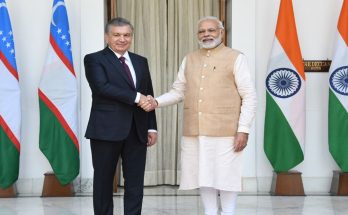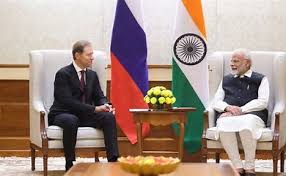 On 26th August, the government formally notified the revised defence FDI policy, which was first announced in the defence and finance minister’s budget speech in July. Coming with immediate effect, the revised policy increases the benchmark FDI cap from 26 per cent to a composite level of 49 per cent under the normal approval route with a further provision that FDI beyond 49 per cent (26 per cent under previous policy) could be allowed if such investment results in access to ‘modern and state-of-the-art technology’. Apart from increasing the FDI cap, the revised policy also deals with numerous other aspects. The commentary examines the key provisions of the revised FDI policy and the likely impact on flow of foreign funds to Indian defence industry.
On 26th August, the government formally notified the revised defence FDI policy, which was first announced in the defence and finance minister’s budget speech in July. Coming with immediate effect, the revised policy increases the benchmark FDI cap from 26 per cent to a composite level of 49 per cent under the normal approval route with a further provision that FDI beyond 49 per cent (26 per cent under previous policy) could be allowed if such investment results in access to ‘modern and state-of-the-art technology’. Apart from increasing the FDI cap, the revised policy also deals with numerous other aspects. The commentary examines the key provisions of the revised FDI policy and the likely impact on flow of foreign funds to Indian defence industry.
With increase in the FDI cap, the government has also made a change in the kind of foreign investments permitted in Indian defence industry. It is to be noted that under the earlier policy, the foreign portfolio investment in Indian defence industry was either banned, or capped at an arbitrary level for certain companies, causing a lot of dissatisfaction among several listed Indian companies which had pleaded their genuine helplessness in controlling such investments given their nature of flow. The revised policy takes cognisance of this problem and allows all kinds of foreign investments within a composite cap of 49 per cent. These investment include besides Foreign Direct Investment (FDI), Foreign Institutional Investment (FIIs), Foreign Portfolio Investment (FPIs), and investments by Non Resident Indians (NRI), Foreign Venture Capital Investors (FVCI) and Qualified Foreign Investors (QFI). However except for FDI, all other foreign investments which are considered ‘hot money’ are capped at a maximum 24 per cent. This is to ensure that such money does not influence the key decision making power of the company as stipulated in the Indian Companies Act.
It is also to be noted as per the revised policy, the portfolio investment is permitted through automatic route, meaning that no prior government approval is required for such inflow of funds. But for the non-portfolio investment, the government has retained its right to decide on each proposal. For up to 49 per cent, the approval body is the Foreign Investment Promotion Board (FIPB) constituted in the Department of Economic Affairs of the Ministry of Finance. However, if the total investment within the limit of 49 per cent exceeds Rs. 1200 crore, it would be approved by the Cabinet Committee on Economic Affairs (CCEA). FDI beyond 49 per cent – a possibility which the revised policy does not lose sight of – is to be approved by the Cabinet Committee on Security (CCS), provided such investment leads to India’s access to modern and state-of-the art technology. However, like the previous policy, the revised policy is also silent as to what is modern and state of the technology.
Apart from increasing the FDI cap, the government has also made a subtle change in the provision of ownership and control of the joint ventures (JVs) to be set up through the revised FDP cap. The change is brought by omitting the term ‘defence’ from the paragraph 4.1.3(v)(d) of the extant Consolidated FDI Policy that requires, for the purpose of ownership and control of JVs in defence and information and broadcasting (I&B) sectors, a minimum 51 per cent equity stake by the single largest resident Indian shareholder. It is to be noted that such condition was a nightmare for many companies – especially those listed in the stock exchanges – which despite having a control of the management of their entities did not have 51 per cent equity on their own. However, to fulfil the earlier requirement they had to go through a lengthy legal process of getting other Indian stakeholders to act as a single unit. The revised policy frees them from the unnecessary burden and allows them to attract FDI as long as they control the management of the company
Apart from the above, the revised policy has also made number of other changes. The membership of the FDI licensing committee has been enlarged to include the Ministry of External Affairs (MEA). The MEA’s membership seems to be an attempt to obtain inputs, from the security point of view, on the true intention of external investors. To safeguard against the leakage of sensitive information, the revised policy makes a new provision that the Chief Security Officer of the JVs, irrespective of the FDI limit, must be a resident Indian. Making a departure from the previous policy – under which permission for FDI (of any limit) could be sought by either Indian company or its foreign collaborator – the revised policy stipulates that permission for FDI up to 49 per cent must be sought by Indian partner only. However FDI beyond 49 per cent, both the Indian partner and its foreign collaborator are allowed to apply.
Having made all the above mentioned changes in the defence FDI policy, the big question now arises as to what would be likely impact on the flow of foreign funds to Indian arms industry. From the foreign companies’ point of view, the increase in the benchmark FDI cap to 49 per cent does not still give them management control of JVs, which is key to transfer proprietary technology. This is also the main reason why the previous policy did not succeed in attracting big investment. The foreign companies would also be appalled for getting no clarity on what constitutes modern and state of art technology based on which the CCS would take decision for allowing FDI beyond 49 per cent. These two factors are likely to weigh heavily on foreign companies’ decision to make big investment in Indian defence sector. This is however not to indicate that investment scenario post revised FDI policy would remain as subdued as it was earlier. On its part, the government is quite confident that the revised policy would be successful. Such is the confidence that it has removed the earlier provision of mandatory 3-year lock-in period for any inward investment before it can be transferred. The confidence seems to be rooted in government’s policy shift towards indigenisation. With the Defence Procurement Procedure 2013 (DPP 2013) prioritising domestic procurement over direct import, the foreign companies have very little choice other than partnering Indian companies for doing defence business India. In other words, the compelling factor would ensure that Indian companies can attract foreign investment without giving management control to the overseas collaborators. However, the extent to which the Indian companies can succeed depends on the government’s willingness to stick to its articulated policy on indigenisation.
The views expressed in this article are solely those of the author.
Courtesy (IDSA)
Author Profile
- India Writes Network (www.indiawrites.org) is an emerging think tank and a media-publishing company focused on international affairs & the India Story. Centre for Global India Insights is the research arm of India Writes Network. To subscribe to India and the World, write to editor@indiawrites.org. A venture of TGII Media Private Limited, a leading media, publishing and consultancy company, IWN has carved a niche for balanced and exhaustive reporting and analysis of international affairs. Eminent personalities, politicians, diplomats, authors, strategy gurus and news-makers have contributed to India Writes Network, as also “India and the World,” a magazine focused on global affairs.
Latest entries
 DiplomacyOctober 4, 2025UNGA Resolution 2758 Must Not Be Distorted, One-China Principle Brooks No Challenge
DiplomacyOctober 4, 2025UNGA Resolution 2758 Must Not Be Distorted, One-China Principle Brooks No Challenge India and the WorldJuly 26, 2025MPs, diplomats laud Operation Sindoor, call for national unity to combat Pakistan-sponsored terror
India and the WorldJuly 26, 2025MPs, diplomats laud Operation Sindoor, call for national unity to combat Pakistan-sponsored terror India and the WorldJuly 25, 2025When Fire Ends, Diplomacy Begins
India and the WorldJuly 25, 2025When Fire Ends, Diplomacy Begins India and the WorldJuly 16, 2025Operation Sindoor and its Aftermath: India’s Successful Diplomatic Outreach
India and the WorldJuly 16, 2025Operation Sindoor and its Aftermath: India’s Successful Diplomatic Outreach







